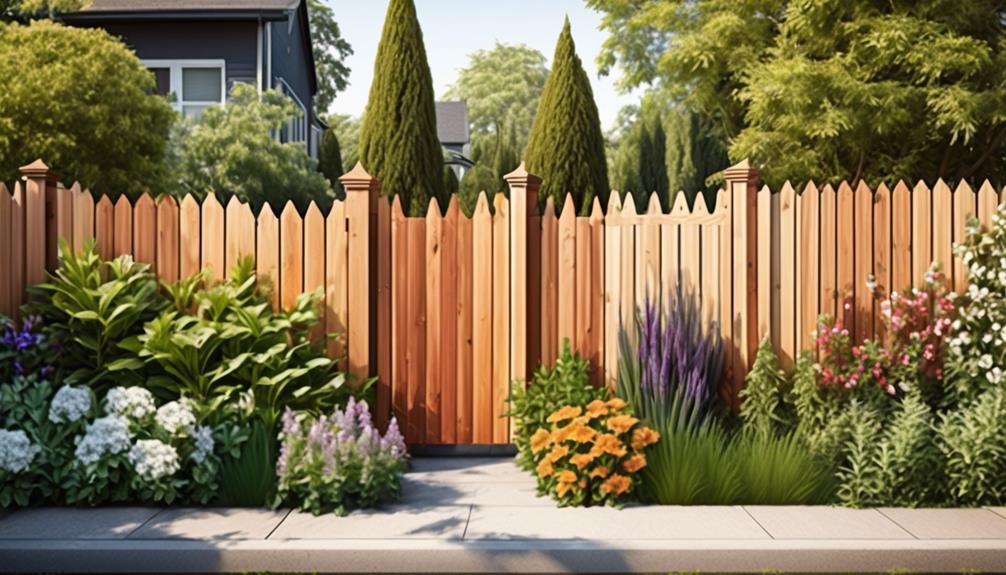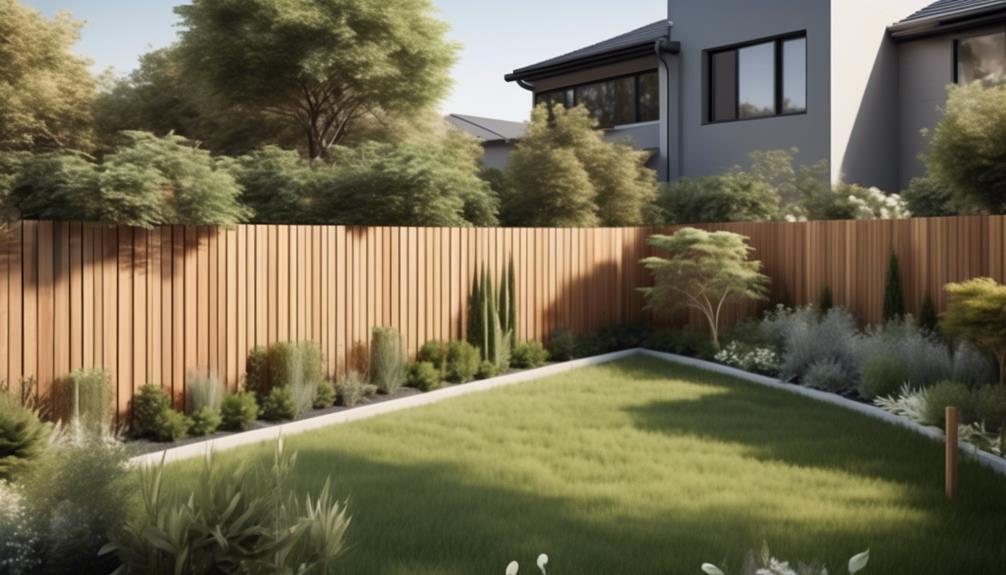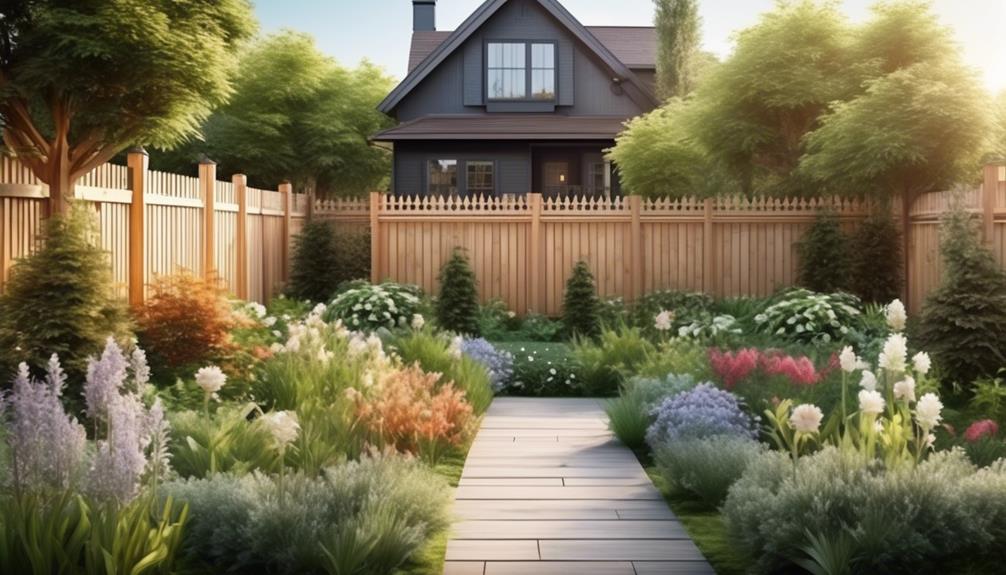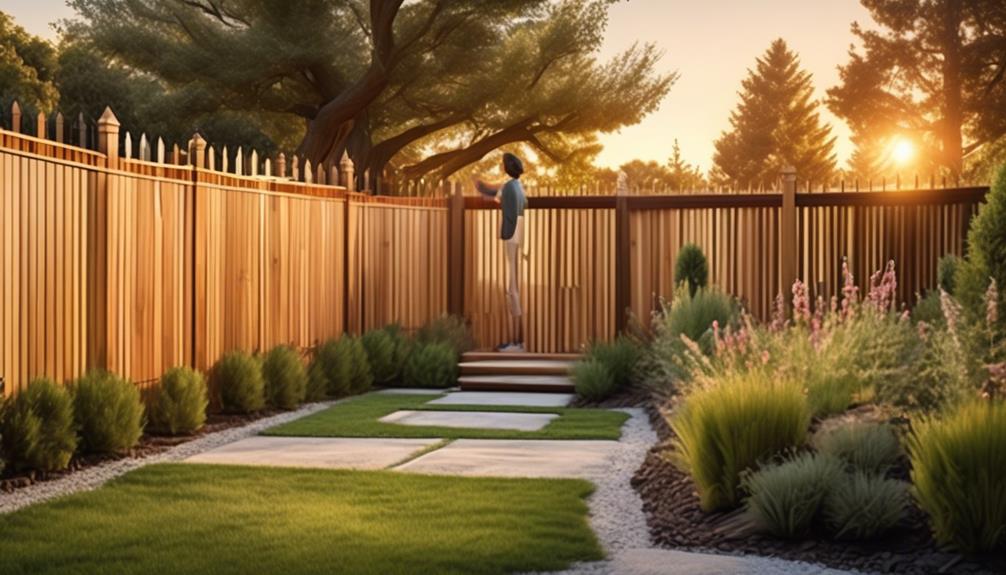Our homes are personal retreats, and the right fence height ensures they remain so, blending beauty with practicality.
You should read this article because it offers guidance on selecting the ideal height for your timber fence.
From keeping in line with local regulations to maintaining the aesthetic appeal of your garden, we’ll help you find the perfect balance.
Whether you’re looking to increase privacy or add value to your property, understanding the importance of fence height is key.

1. Understanding the Importance of Fence Height
You must consider the fence height as it greatly affects your privacy and security.
A well-chosen height can also reduce noise and control wind flow, enhancing your outdoor comfort.
Be mindful of local regulations and how the aesthetics of your fence will harmonise with your home and neighbourhood.
A. Impact on Privacy and Security
Opting for a higher wooden fence can significantly improve your personal space by preventing neighbours from looking into your yard. However, if you choose a shorter fence, you might want to consider using lattice panels or growing climbing plants for extra privacy.
The height of your fence is directly related to how much privacy you have. While lower fences can be friendly and less intimidating, they do little to hide your outdoor activities from those around you. Installing lattice panels on top of your fence can be a subtle way to add height, or you could use vines and other climbing plants for a more natural barrier.
It’s also worth thinking about how fence height affects security. A taller fence can act as a deterrent to potential intruders, serving both as a mental and physical boundary. When deciding on the height of your fence, it’s important to weigh both privacy and security benefits.
B. Noise Reduction and Wind Control
Have you considered the impact a taller wooden fence could have on reducing noise and sheltering your garden from the wind? A high fence can act as a shield, keeping out sounds from traffic or nearby conversations.
However, the height isn’t the only factor; choosing the right wood is crucial as some types absorb sound better, although they might need more upkeep. It’s also important to ensure the fence is sturdily built – a fence that blocks the wind well must have a solid base.
It’s also worth considering the local weather when deciding on the height and design of your fence, as some options work better under certain conditions.
Carefully selecting both the height and material of your wooden fence will help make your outdoor area a more peaceful and protected place to relax.
C. Local Regulations and Aesthetics
Before you settle on the final design for your timber fence aimed at reducing noise and managing wind, it’s important to take a close look at the laws in your area and think about how the height of your fence will fit in with the look of your neighbourhood.
Make sure to contact your local council to understand what the zoning laws are because they’ll have the final say on how tall or short your fence can be. If your home is in a historic area, there might be specific rules about what materials you can use to ensure the area keeps its traditional appearance.
It’s also necessary to follow safety regulations to make sure your fence doesn’t block the view for drivers or pedestrians. And remember, it’s always a good idea to be clear about where your property ends to prevent any disagreements with your neighbours.

2. Exploring Height Options and Their Applications
When you’re choosing the right height for your timber fence, consider the purpose it’ll serve.
Short fences, ranging from 0.9m to 1.2m, are great for demarcating boundaries without obstructing views.
Mid-range fences, from 1.2m to 1.8m, offer more privacy and security.
If you’re aiming for maximum privacy and security, you’ll want to look at tall fences that stand at 1.8m and above.
A. Low Fences (0.9m – 1.2m)
Short fences, with heights between 0.9m and 1.2m, are perfect for adding definition to garden areas like flowerbeds and paths, whilst also marking the edges of your property. The advantages of a shorter fence include a more open look and better sunlight for your plants, along with being more economical due to their reduced size. However, whilst a taller fence might give you more privacy, it could also cast too much shade in a small garden.
Short fences are easy to maintain and their simple design is great for those who like to do their own home projects, potentially saving costs. Keeping a short fence tidy can really make your home’s frontage look better.
B. Mid-range Fences (1.2m – 1.8m)
Mid-range fences that stand from 1.2 to 1.8 metres high provide a good mixture of privacy and a sense of openness in your garden or yard. These fences are a common choice for marking property boundaries because they offer enough privacy without making you feel boxed in. They also help in keeping your home secure by deterring intruders, while still allowing you to enjoy the scenery around your property.
For those who have dogs or cats, these fences are effective at keeping your pets inside your yard without needing excessively tall barriers. To enhance the appearance of your wooden fence, consider adding design features. You can add decorative tops or horizontal boards that not only look aesthetically pleasing, but also serve the fence’s practical purpose.
C. High Fences (1.8m and above)
For those who prioritise a private and tranquil backyard, installing a timber fence taller than 1.8 metres can offer seclusion and a shield from outside noise or harsh weather conditions. Yet, it’s worth considering that these high fences might block views and sunlight, potentially making your outdoor space feel less open and welcoming.
Maintenance is another aspect to think about, as taller fences mean more area to care for, which translates to more time and money spent on upkeep. When planning for a fence of this stature, factor in the higher initial costs for materials and the possibility of hiring professionals for installation.
Choosing durable, high-quality timber is important to ensure that your fence can endure the elements and last a long time. Before you decide to install a tall fence, weigh the commitment against your desire for privacy to make sure it’s the right choice for your space.

3. Factors to Consider for Choosing the Ideal Height
When selecting the ideal height for your timber fence, you must consider several critical factors.
Consider the fence’s intended purpose and function, as these will largely dictate the necessary height for privacy, security, or containment.
Additionally, the size and layout of your garden, along with desired views and aesthetic appeal, play pivotal roles in this decision.
A. Purpose and Function
Determining your fence’s ideal height starts with a clear understanding of its primary purpose, whether that’s ensuring privacy, enhancing security, or keeping pets safely contained. The purpose and function of your fence greatly influence its optimal stature.
A taller fence may be necessary if the impact on privacy is a top concern, as it can shield your property from prying eyes. Conversely, if noise reduction and wind control are more significant, the right height can serve as a sound barrier and provide shelter from the elements.
Be mindful of local regulations and aesthetics, as these will affect height options and applications. Always check with your local council for any restrictions. Tailor your fence height to balance practicality with the style of your home and garden.
B. Garden Size and Layout
When selecting the appropriate fence height, consider how it will fit with the size and shape of your garden. A tall fence may be excessive for a small garden, disrupting the balance, whereas a low fence in a large garden may not provide sufficient privacy.
It is crucial to plan your space effectively so that your fence enhances the desired level of privacy while still complementing the design of your garden. Take into account the size of your garden and how it compares to the surrounding area. A fence that is too high can create a sense of enclosure, while one that is too short may not afford the desired level of privacy.
Strive to find a height that is suitable for both the functionality and aesthetics of your garden.
C. Perspectives and Aesthetics
When selecting the right height for your fence, consider how it can either reveal or conceal the views from your property and how it will fit with the look of your yard. A fence that’s too high could block beautiful landscapes from sight, while one that’s too low might not give you the privacy you desire. Choosing materials that match the environment, like a wooden fence that complements trees and gardens, is wise.
It’s also important to think about how the fence looks alongside your house and the rest of your yard. A mismatch in height can make it stick out awkwardly. Don’t forget to take into account your neighbours’ perspectives and privacy. A well-chosen fence height not only increases the visual appeal of your home but also contributes to a harmonious community atmosphere.

4. Expert Tips for Achieving Timber Fence Harmony
To ensure your timber fence complements your property, you’ll want to use visualisation tools to preview potential heights and styles.
Look around your neighbourhood for fence designs that resonate with you and consider how they might enhance your own space.
Keep in mind that a fence’s design can be tailored; don’t hesitate to mix elements to suit your unique aesthetic and functional needs.
A. Experiment with Visualisation Tools
Before you decide on the height of your timber fence, it’s a good idea to use visualisation tools or create simple representations to preview the different heights in your actual environment.
This kind of visual representation helps you make choices based on what you can see, rather than guesses. Also, interactive design programmes let you adjust the fence dimensions easily, giving you control over the design process. With 3D models, you get a 360-degree view of the fence under various lighting, ensuring that the height you choose fits your outdoor area just right.
Checking with experts in landscaping can also help to fine-tune your plans and ensure that your fence fits naturally into your garden’s design.
B. Draw Inspiration from Existing Installations
Looking at homes in your area with gardens like yours can give you a good idea of how high your wooden fence should be to ensure it fits well with your property and matches what’s popular locally. Take a stroll around neighbourhoods that have a similar size and style to your garden to see what types of fences they have.
This step helps you determine not only what looks aesthetically pleasing but also what is practical. Take note if the fences provide sufficient privacy while still allowing the garden to be the focal point. Check if they are tall enough to maintain the security of the area.
Additionally, consider how your fence might impact the appearance of your street. A fence that is significantly taller or shorter than others in the vicinity could appear out of place. Aim for a height that allows your property to stand out while still harmonising with the rest of the neighbourhood.
C. Remember Flexibility and Customisation
Have you considered a fence that combines different heights and styles to match the unique aspects of your garden? Choosing a flexible design allows you to create a distinct appearance that is both aesthetically pleasing and practical. For instance, incorporating gates or decorative fence panels can enhance privacy without necessitating the entire fence to be very tall.
Integrating landscaping can also offer imaginative ways to enhance the appearance and provide more privacy. By varying the heights of the fence, you can customise it to meet specific requirements, such as taller sections for more secluded areas and shorter parts to preserve the view where desired. It’s all about striking the right balance between maintaining privacy in certain areas and upholding the overall design of your garden.

Conclusion
When selecting the right height for your wooden fence, you should consider how much privacy and security you desire, as well as how the fence will look. It’s also important to adhere to any local zoning laws and neighbourhood guidelines to avoid potential legal issues. A taller fence can provide more privacy but may require additional upkeep.
Think about how your fence will serve its purpose while still fitting in with the overall aesthetic of your property and community. If you’re ready to decide or if you need tailored advice, feel free to seek guidance or look into services that specialise in fence design and installation. The right fence for your needs is out there.
Remember to find a balance between function and style within the framework of your local regulations.
When you’re prepared to decide or need further customised suggestions, don’t hesitate to call us on 0452 280 559 for expert timber fence installation services. The ideal fence for you is within reach.
